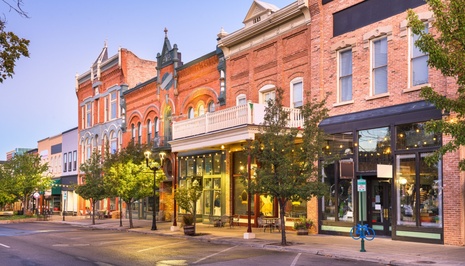Main Streets are a quintessential part of many communities across the U.S. and one of the most valuable economic drivers of success for a community if they are equipped to leverage the area strategically.
The Funding Gap Is the Difference Between Plans and Outcomes
For most communities, the most significant constraint isn't vision. It's funding.
Main Street programs depend on dedicated revenue sources, staff, and long-term campaign planning. Many chambers, economic development organizations, and nonprofits are forced to operate from grant cycle to grant cycle, limiting their ability to scale successful strategies or respond to market opportunities.
That's where Convergent Nonprofit Solutions comes in.
We work directly with local leaders to build structured funding campaigns that align with measurable goals. These campaigns are designed to fund Main Street program operations, support staff capacity, and generate long-term revenue through reinvestment.
Downtown and Main Street Revitalization Delivers Measurable Returns
According to the 2024 annual report from Main Street America, nearly 2 million Americans live in designated Main Street districts, and almost half the U.S. population lives in a county that includes one. In 2024 alone, 400 million people visited a Main Street, helping drive both consumer spending and community identity.
The economic output is quantifiable with:
- $5.68 billion in local reinvestment
- 35,162 net new jobs
- 6,630 new businesses opened
- 10,556 buildings rehabilitated
- 1.66 million volunteer hours contributed
With 2.67 million jobs supported nationally and 1,228 active Main Street programs, the model continues to show that local economies can grow from within, mainly when resources are focused on downtown cores. Every $1 invested in local Main Street program operations returns $18.03 in new public and private investment. That's not an estimate; it's based on data reported by communities putting the model to work.
Still, strong outcomes aren't automatic. Successful revitalization requires long-term commitment, stable funding, and aligned leadership, conditions that can be hard to maintain in under-resourced or rural communities.
That's where chambers of commerce, economic development groups, and municipal leaders play a critical role. When they coordinate around shared priorities — property reuse, small business development, public infrastructure — they help turn empty storefronts and neglected buildings into productive assets that generate tax revenue, jobs, and momentum.
The ROI of Main Street Revitalization
The economic returns of a strong Main Street district are well-documented:
1. Local Business Growth
Downtown districts give small businesses better visibility, foot traffic, and access to customers. Restaurants, retailers, service providers, and even light manufacturers benefit from shared infrastructure and reduced startup costs, making Main Street a reliable launchpad for local enterprise.
2. Competitive Advantage in Talent Retention
Walkable, active districts appeal to workers who want more than just a job. Access to public spaces, local amenities, and shorter commutes improves retention, especially among younger professionals and skilled tradespeople. Main Streets help employers stay competitive in tight labor markets.
3. Lower Infrastructure Costs
Centralized development costs less to serve over time. Compared to low-density sprawl, compact downtowns make more efficient use of roads, water, sewer, and public transportation, stretching infrastructure dollars further and easing long-term maintenance burdens.
4. Long-Term Economic Stability
A strong Main Street creates more than curb appeal. It anchors a place-based economy that supports business diversity, draws investment, and builds financial resilience through a broader, healthier tax base.
Tools for Targeted Growth
Placemaking strategies and incentive tools — Tax Increment Financing (TIF), Special Service Areas (SSA), and Business Improvement Districts (BIDs) — are gaining traction in communities focused on long-term downtown activation.
Meanwhile, data tools like the BOOMS Tracker (Building Opportunities on Main Street) from Main Street America are helping leaders understand the current and future value of their built environment. The tool allows communities to document vacant or underutilized properties, analyze what's missing, and model the economic potential of reinvestment.
Build the Capacity Your Downtown Needs With Convergent Nonprofit Solutions
The results speak for themselves. For every $1 invested in Main Street operations, $18.03 is returned to the local economy. But reaching those numbers takes more than good intentions. It requires funding models designed to last.
If your Main Street program is underfunded or underutilized, there is a path forward. A structured campaign can equip your team with the resources to attract investment, support business formation, and deliver results that stand up to public scrutiny. Talk to our team about launching a funding campaign tailored to your downtown strategy.






